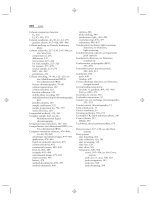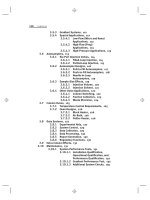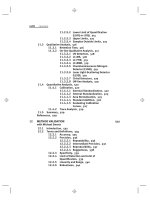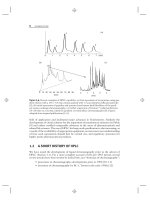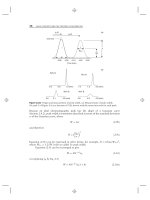Introduction to Modern Liquid Chromatography, Third Edition part 26 pptx
Bạn đang xem bản rút gọn của tài liệu. Xem và tải ngay bản đầy đủ của tài liệu tại đây (331.45 KB, 10 trang )
206 THE COLUMN
Vydac-214-TPS
Halo-90
Zorbax-PSM-300
Nucleosil-7-300
(a)
Zorbax 3.5 μm Halo 2.7 μm
Atlantis 3 μm Luna 3 μm
(b)
Figure 5.2 Visual appearance of several silica particles for RPC; magnification in (b)is7×
greaterthanin(a).
±15–20% (1 SD) particle-size distribution for most commercial packings of similar
size [5], as in the example of Figure 5.4. Computer simulations [10] suggest that a
narrower particle-size distribution should result in columns with larger values of N,
as well as improved permeability (i.e., a lower pressure drop, other factors equal);
see also [11, 12]. Columns with a narrower range in particle size are also more
stable [13].
5.2 COLUMN SUPPORTS 207
20
18
16
14
12
10
8
6
4
2
0
2 4 6 8 10 12
H (μm)
mobile-phase velocity (mm/sec)
5-μm totally porous
3.5-μm totally porous
1.8-μm totally porous
2.7-μm superficially porous
Figure 5.3 Column efficiency as a function of particle size and type. Sample, naphthalene.
Conditions: 50 × 4.6-mm, C
18
columns; mobile phase is 60% acetonitrile-water mobile phase;
23
◦
C. Courtesy of Advanced Materials Technology.
3000
2500
2000
1500
Number of particles
1000
500
0
123456
7
Particle diameter, μm
Halo particle-size-distribution
Average = 2.77 μm (± 6%, 1 SD)
3-μm commercial packing
Average = 3.78 μm (± 19%, 1 SD)
Figure 5.4 Narrower particle-size-distribution for the superficially porous (Halo™)pack-
ing of Figure 5.3, compared with that of a commercial totally porous packing. Courtesy of
Advanced Materials Technology.
A second possible reason for the exceptional efficiency of the superficially
porous column of Figure 5.3 is the higher density of these particles (∼1.4 g/cc),
which is 30–70% greater than that of totally porous particles. A more dense particle
may pack more efficiently, as is the case for larger particles. Figure 5.5 shows a
transmission electron micrograph cross section of a superficially porous particle,
whose structure has a higher density solid core and a porous shell. Figure 5.6a shows
208 THE COLUMN
Figure 5.5 Cross-section of superficially porous (Halo™) particles with 9-nm pores (electron
micrograph). Courtesy of Advanced Materials Technology.
1
2
3
4
5
6
7
8
9
0.0 0.1 0.2 0.3 0.4 0.5 0.6 0.7
(min)
Figure 5.6 Fast separation by means of a superficially porous column. Sample: 1, acetone;
2, tebuthiron; 3, thiazuron; 4, fluometuron; 5, diuron; 6, propanil; 7, siduron; 8, linuron; 9,
diflubenzuron. Conditions: 50 × 4.6-mm Halo C
18
column (2.7-μm particles); mobile phase
is 45% acetonitrile/water mobile phase; 4.0 mL/min; 60
◦
C; 3400 psi. Courtesy of Advanced
Materials Technology.
an example of a very fast separation of a herbicide sample by means of a 2.7-μm
superficially porous column.
5.2.2.2 Nature of the Silica Surface
The chemical nature of the unmodified silica surface (which varies with the man-
ufacturing process) strongly influences its properties [14–17]. A surface layer of
silanol groups (–SiOH) with a concentration of ≈8 μmoles/m
2
is a feature of all
fully hydrated silicas; these silanol groups must be present for the reaction of silanes
with the silica to form a bonded phase (Section 5.3.1). Most of these silanol groups
5.2 COLUMN SUPPORTS 209
(d)(e)
M
+
Surface metal Internal metal
(activated silanol)
O
−
M
+
Si
H
+
e
−
OH
(a)
Si
Free silanol
HO OH
(b)
Si
Geminal silanols
OH
(c)
OH
Si Si
Associated silanols
- - -
Figure 5.7 Silica surface showing different types of silanols.
are lost when silica is heated above 800
◦
C, rendering the silica useless for HPLC.
Three different silanol groups are present on the surface of a hydrated silica [14,
16–20], as illustrated in Figure 5.7a–c. Column performance is strongly affected by
silanol acidity; free (non–hydrogen-bonded) silanols are relatively more acidic and
have been associated with lower values of N and increased peak tailing for basic
solutes.
The purity of the silica support has an even greater effect on silanol acidity and
column performance. Certain metals (especially Al[III] and Fe[III]) are potential con-
taminants that can increase silica acidity by withdrawing electrons from the oxygen
of the silanol (Fig. 5.7e), as well as interact directly with chelating solutes (Figs. 5.7d,
5.20i). These various consequences of metal contamination can result in tailing peaks
and poor recovery for some solutes. Present state-of-the art chromatographic silicas
are much more pure, as illustrated by the data of Table 5.3 for one such silica (tests
also exist for the direct measurement of silica acidity and complexation; Section 5.4.1
and [18, 21]). Silica particles and resulting packings and columns can be classified as
type A or B [15], based on their purity or cation-exchange behavior (Section 5.4.1).
Table 5.3
Representative Analysis by ICP-AES/MS for
Trace Elements in Zorbax Rx-SIL
Element Content (ppm)
Na 10
Ca 2
K <3
Al 1.5
Fe 3
Mg 4
Zn 1
210 THE COLUMN
2
Cation-exchange capacity (meq/g)
46810
pH
Type-B
Type - A
Hybrid
Figure 5.8 Relative acidity (silanol ionization) of different HPLC supports, as measured by
the retention of Li
+
ion. Adapted from [22].
Type-A silicas are less pure and more acidic, and were used exclusively for HPLC
prior to 1990; they are still useful for some less-demanding applications such as
sample preparation (Section 16.6) and preparative chromatography (Chapter 15).
Silanol ionization varies with both silica type and mobile-phase pH, and can be
measured by the relative retention of an inorganic cation such as Li
+
. Figure 5.8
illustrates silica ionization or ‘‘cation-exchange capacity’’ for a type A, a type B,
and a ‘‘hybrid’’ C
18
column (Section 5.3.2.2). The relative acidity of these three C
18
columns decreases in the order type A type B
>
hybrid.
Basic solutes and ionic or ionizable compounds are usually best separated
with newer type-B columns. Figure 5.9 compares the separation of some basic
0 5 10 15 20 25 (min)
(a)
(b)
type-A silica
type-B silica
Figure 5.9 Separation of protonated basic compounds on type-A (a) compared with type-B
(b) columns. Sample: four tricyclic antidepressants. Conditions: 150 × 4.6-mm C
18
columns;
mobile phase is 30% acetonitrile-water with pH-2.5 phosphate buffer. Adapted from [19].
5.2 COLUMN SUPPORTS 211
drugs with C
18
columns based on either type-A and -B silica. The type-B column
(Fig. 5.9b) is seen to provide peaks that are narrower and more symmetrical. The
selection of a less-acidic column as a means of minimizing peak tailing is discussed
in Section 5.4.4.1. Commercial columns that were introduced after 1990 are mainly
type B.
5.2.2.3 Particle Preparation
Several methods are used to prepare particles for HPLC columns. Totally porous
silica particles can be made by a sol-gel procedure, which involves the emulsification
of a silica sol in an immiscible nonpolar liquid, followed by (1) the formation of
droplets and their conversion into spherical beads of silica hydrogel, (2) drying, and
(3) classification into a narrow particle-size range. By controlling pH, temperature,
and the concentration of the silica sol, particles with the desired size and pore
size distribution can be obtained. An alternative approach to emulsification is to
spray-dry silica sols or solutions of finely divided silica, so as to form spherical,
totally porous particles. The resulting pore structure of these materials can be
modified by hydrothermal treatment in an aqueous media (or with steam) at
elevated temperatures and pressures.
Still another approach for preparing totally porous silica particles is to aggre-
gate or assemble microparticles, as illustrated in Figure 5.10. One such procedure
is to disperse a silica sol of defined size in a polar liquid, add a solution of poly-
merizable organic material such as formaldehyde and urea or melamine, and then
initiate the coacervation of the silica with the polymer to form spherical, uniformly
sized aggregates. The resulting material is first heated to eliminate the organic
polymer, and then sintered at higher temperature to strengthen the interconnected
network of silica sol particles. Small, silica-sol particles are used to prepare particles
with smaller pores; larger pores are formed from larger silica sol-particles. This
aggregation method can also be used to prepare totally porous particles of zirconia.
So-called hybrid (organic/inorganic) particles are prepared by the co-poly-
merization of organo-silanes with tetraalkyl-o-silicate or other organic silicates. The
pore structure of particles made by this approach can be modified by appropriate
hydrothermal treatments. After hydrolysis, the surface can be further modified by
reaction with other silanes to produce the desired final ligand.
Superficially porous silica particles are prepared by layering silica-sol particles
onto a spherical, solid core of silica. The general approach is to alternate layers
of oppositely charged organic polymer and negatively charged silica sol until the
desired shell thickness is obtained. The organic interlayer is then removed by heating,
microparticles of silica spherical composit
e
Figure 5.10 Aggregation of microparticles to form totally porous particles.
212 THE COLUMN
and the particles are strengthened by sintering. Small particles of the silica sol create
smaller pores, while larger silica sols are used for larger pores.
An ‘‘inverse’’ approach has been used to make graphitized-carbon particles
(Section 5.2.5.3). For example, a polymerizable organic material is introduced
into the pores of silica particles and polymerized within the pores. The resulting
silica/polymer particles are treated with hydrofluoric acid to dissolve the silica sol
and leave spherical, porous-polymer particles. Finally, these particles are heated to
a high temperature in the absence of oxygen for graphitization. For further details
of the preparation of particles for HPLC columns, see [1].
5.2.3 Porous Polymers
Porous-polymeric particles (primarily, cross-linked polystyrene) have been used
for reversed-phase, ion-exchange, and size-exclusion columns. Other polymers, for
example, substituted methacrylates and polyvinyl alcohols, are also commercially
available—but are used less often. Polymeric columns can be derivatized with RPC
ligands, such as –C
18
,–NH
2
,and–C≡N in order to create differences in column
selectivity, or with ionic groups for use in ion-exchange chromatography. Compared
to the number of commercially available silica-based packings, however, only a small
number of different RPC ligands are currently available for polymer-based particles.
A main advantage of porous, cross-linked polystyrene particles is that they are pH
stable; any mobile-phase pH is acceptable (0 ≤ pH ≤ 14). Polymeric columns can
be used for the RPC separation of strongly basic samples at pH ≥ 10, in order to
suppress sample ionization and avoid the tailing peaks that are sometimes seen with
silica-based packings (Section 7.3.4.2). However, newer, type-B RPC columns that
are stable at higher pH have largely replaced the latter application.
Polymer-based particles modified with ionizable functional groups (–COOH,
–SO
3
H, –NH
2
, and NR
+
3
) are used mainly for ion-exchange separations (Sections 7.5,
13.4.2). Polymeric columns can be made with narrow pores for the separation of
small solute molecules, or wide pores for large molecules such as proteins. Because
of their stability at high pH, these polymer-based columns allow strongly retained
sample contaminants to be purged from the column with 0.1 M sodium hydroxide
(Section 13.4.2.1).
Some limitations exist on the use of porous, polymer-based packings. These
columns exhibit lower values of N, compared to silica-based columns with particles
of similar size. A potential problem with polymer particles is that they can swell
(or shrink) to varying extents with different organic solvents, and thus cause loss
of column efficiency or increase in column pressure. Adverse effects due to particle
swelling are more noticeable in gradient elution because the B-solvent concentration
(%B) changes during the separation. Some polymeric packings have been designed to
minimize swelling, however, rendering them suitable for use with gradient elution.
5.2.4 Monoliths
Since 1990 monoliths have received increasing attention. Monolithic columns are
cast as a coherent, rigid cylinder by in situ polymerization, and they can be
made from either silica or polymer. Figure 5.11 shows electron micrographs of
monoliths made from (Fig. 5.11a) silica and (Fig. 5.11b) polymer. Monoliths
are available as either columns or disks; the latter are used primarily for peptide
5.2 COLUMN SUPPORTS 213
(a)
(b)
Figure 5.11 Cross section of representative monolith packings (electron micrographs). (a)
Silica-based; (b) polymeric. Reprinted from [23] with permission of EDM Chemicals Inc. (a)
and F. Svec (b).
synthesis and other applications of biological interest, and these will not be discussed
further. This section describes both silica- and polymer-based monolithic columns,
their advantages and limitations, and some important applications. The history,
development, and characteristics of monoliths have been reviewed [24–27].
5.2.4.1 Silica-Based Monoliths
Silica monoliths are prepared as rods from a single piece of porous silica, so
packing particles into a length of column tubing (Section 5.6) is no longer required.
Commercial monoliths are not produced inside a column blank; rather, the monolith
is formed, dried, and then encapsulated with a polymeric coating. The surface
modification of the resulting silica monolith (e.g., the bonding of C
18
ligands) is
carried out later. The monolith bed contains pores of two types: large macropores,
with diameters of ∼2 μm, and small mesopores with diameters of ∼10 nm. The
resulting surface area (e.g., 300 m
2
/g) is contributed mainly by the mesopores,
while flow through the column occurs in the macropores. The interstitial volume
of a conventional packed bed is about 40% of the column volume, and this is
virtually independent of particle size or particle-size distribution. Monoliths, on the
other hand, can be made with interstitial volumes (defined as the volume of the
macropores) as high as 80%.
214 THE COLUMN
The diameters and total volume of the monolith macropores determine column
permeability and the pressure required to achieve a certain flow rate. Because these
macropores are quite large, the required pressure for flow through a monolith is
much less than for conventional columns of packed particles with ‘‘equivalent’’
particle diameters d
p
(as estimated from later Eq. 5.5). Compared to particulate
columns, higher flow rates can be used with monoliths, without a corresponding loss
in column efficiency. One study with small-molecule solutes suggests that commercial
monolith columns have efficiencies that are equivalent to columns packed with 4-
to 5-μm particles [28]. An important question is how monoliths compare with
conventional packed columns in both pressure drop and values of N. Another
study suggests that monolithic columns are only beneficial when high-resolution
separations are needed (e.g., N
>
100,000) [29], but not all investigators agree [30].
For further details on how monoliths compare with conventional packed columns,
see the review of [24].
Some limitations for silica-based monoliths include a restricted range of
available column dimensions, a limited variety of stationary phases, and a tendency
of available materials to exhibit tailing peaks (e.g., tailing factor ∼1.2), even for
neutral (non-ionizable) compounds [28]. At the time that the present book was
written, monoliths were finding only limited application in routine laboratories, but
research at that time was promising [31], especially for capillary monolith columns.
Limited studies also suggest that silica-based monoliths can be prepared with a
reproducibility that is acceptable for routine analysis [28, 32]. The future impact of
these columns remains to be seen.
5.2.4.2 Polymer-Based Monoliths
Monoliths made from organic polymers are available for a wide range of applica-
tions. These columns can be made by the copolymerization of monomers such as
styrene/divinylbenzene with monovinyl/divinyl methacrylate. The copolymerization
of other monomers with different functionalities allows the formation of particles
with different ligands and RPC selectivity. These polymeric monoliths are directly
formed into column tubes, including capillary columns (0.5-mm diameter and
smaller). During the production of a monolith, two sets of characteristics can be
controlled simultaneously: the nature of the polymerizable material and the pore
structure. Polymer-based monoliths with wider pores appear well-suited for the
separation of large biomolecules (peptides, proteins, oligonucleotides, etc.), as well
as for capillary columns, where long lengths can be used for separating complex
mixtures that require large N [33].
5.2.5 Other Inorganic Particles
Although silica is usually the preferred support material, packings based on other
inorganic structures have been found useful for certain applications. This section will
review these other inorganic supports and describe their preferred use. Unmodified
metal oxides have a different surface chemistry than silica, which has led to three
different procedures for attaching the stationary phase: (1) deposition of a polymer
or carbon layer onto the surface, (2) covalent attachment of a ligand, and (3) use of
a strongly interacting mobile-phase additive. We will describe particles made from
zirconia, alumina, titania, and graphitized carbon. Table 5.4 lists some commercially
5.2 COLUMN SUPPORTS 215
Table
5.4
Commercially Available Column-Packings Based on Zirconia or Alumina
Column Packing
a
Particle Particle % Carbon Pore Size Surface
Type Diameter (μm) (nm) Area (m
2
/g)
ZirChrom-PBD Zirconia 3 or 5 na
b
30 30
ZirChrom-PS Zirconia 3 or 5 na 30 30
Aluspher RP-select B Alumina 5 na 10 170
Millpore PBD Alumina 5 7.2 9 110
Unisphere Alumina 10 5.1 22 37
GammaBond RP-1 (PBD) Alumina 5 na 8 na
GammaBond RP-8 Alumina 5 na 8 na
a
Taken in part from [35].
b
Not available.
Table 5.5
Comparison of Silica and Metal-Oxide Particles for Chromatography
Property Silica Titania Alumina Zirconia
Particle monodispersity 3 2 2 2
Pore structure 3 na
b
na 2
Surface area/pore diameter 4 2 2 2
Surface chemistry 3 na 2 2
Mechanical strength 4 na na 4
Chemical stability 2 2 3 4
Thermal stability 2 na na 4
Column efficiency 3 na 2 3
Energetic homogeneity
a
31 1 1
Note: Ratings from low or neutral (1) to high or favorable (4).
a
Particles other than silica possess strong adsorption sites, which can lead to low values of N and incom-
plete recovery of the sample.
b
Not available.
available columns based on zirconia and alumina. Some advantages and limitations
of columns made from various inorganic supports are summarized in Table 5.5.
5.2.5.1 Zirconia
The covalent bonding of a ligand onto zirconia particles has been generally unsuc-
cessful, because the ligand-particle bond has proved to be unstable under most
conditions used for RPC. Useful zirconia-based packings are usually made by
depositing or polymerizing an organic phase onto the particle surface. Polybutadiene
or polystyrene is the usual stationary phase, resulting in packings whose selectiv-
ity is somewhat similar to that of alkylsilica packings (at least for non-ionizable
solutes). These polymer-based zirconia materials show outstanding stability for both
